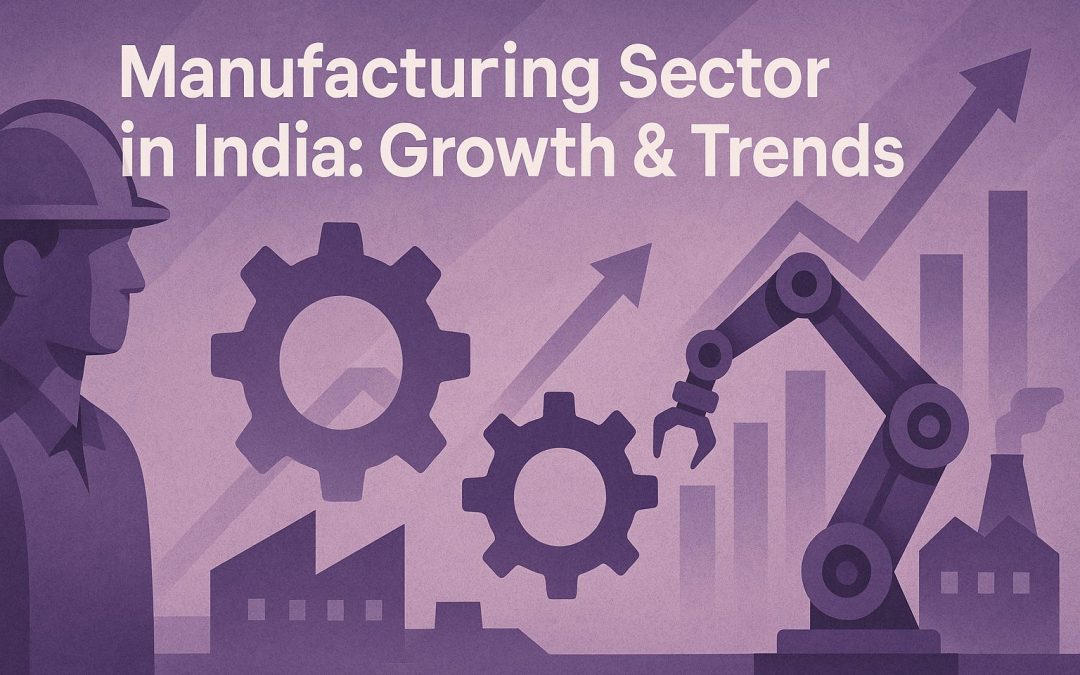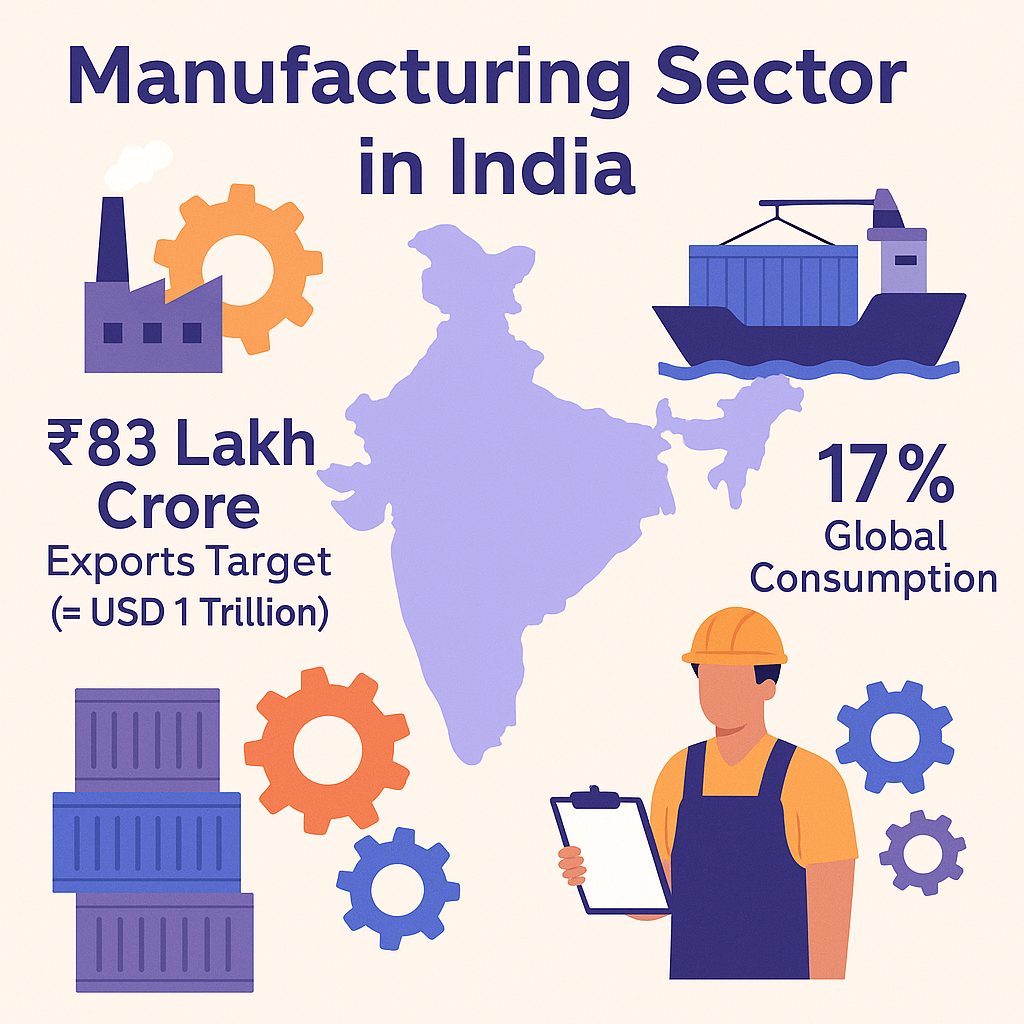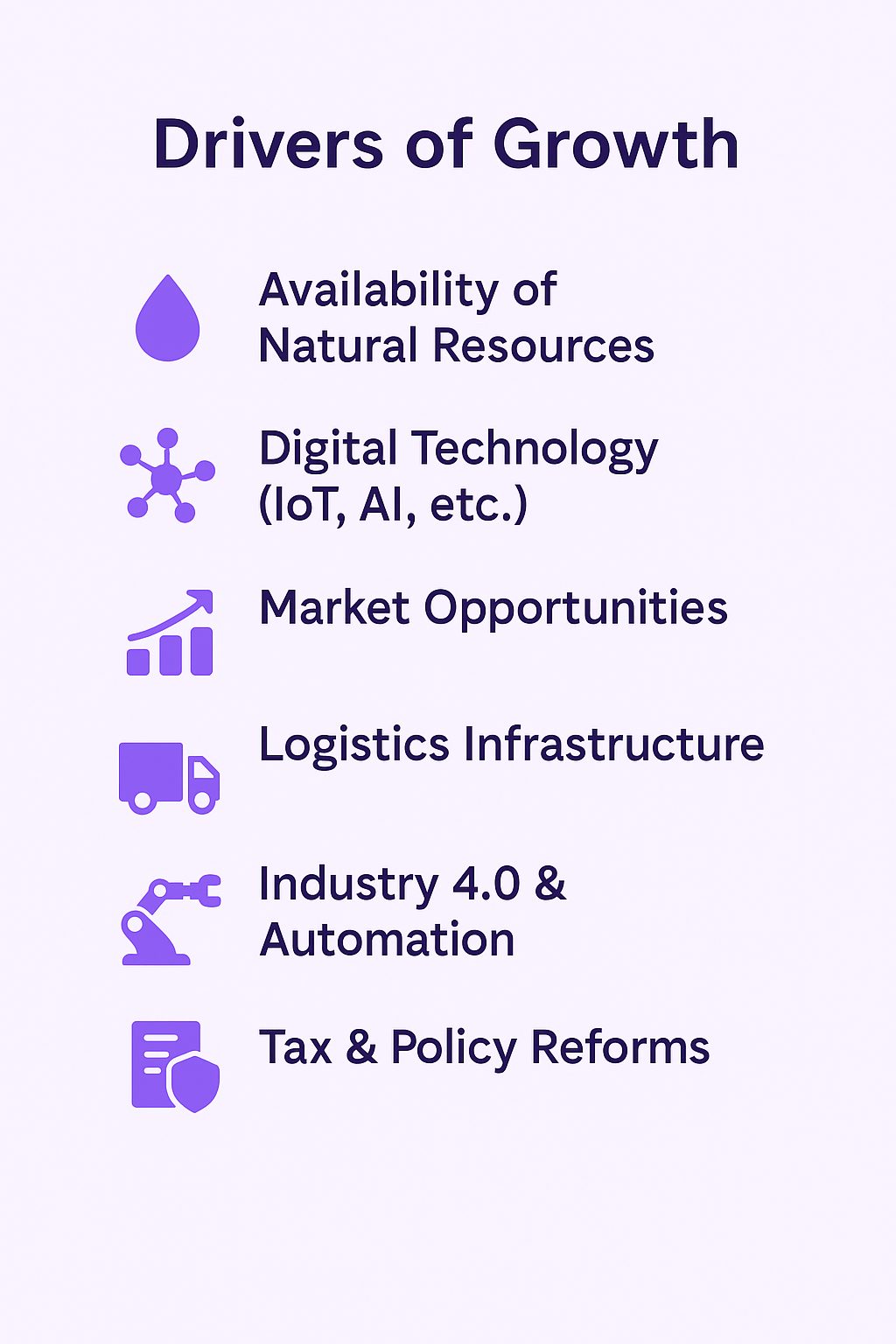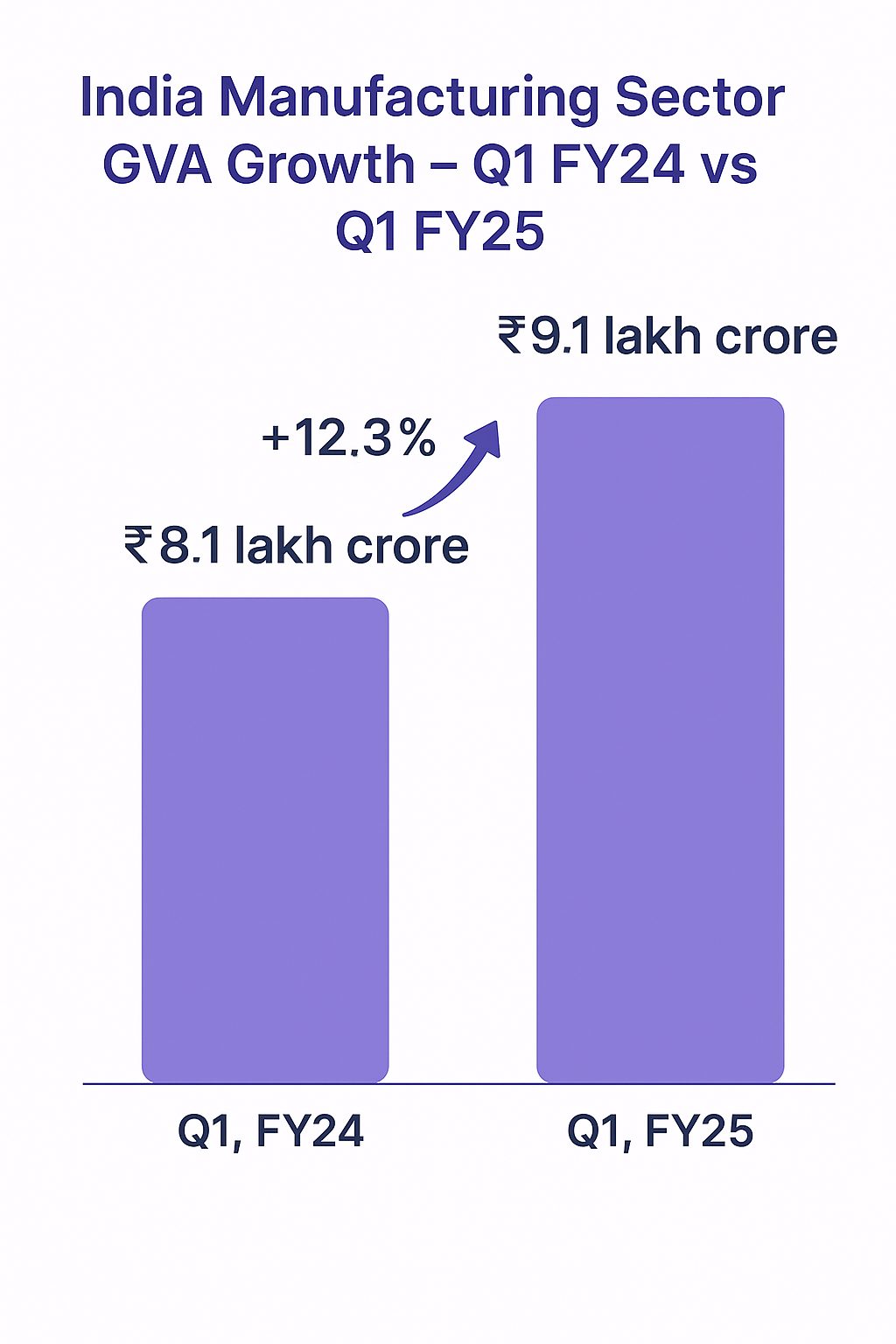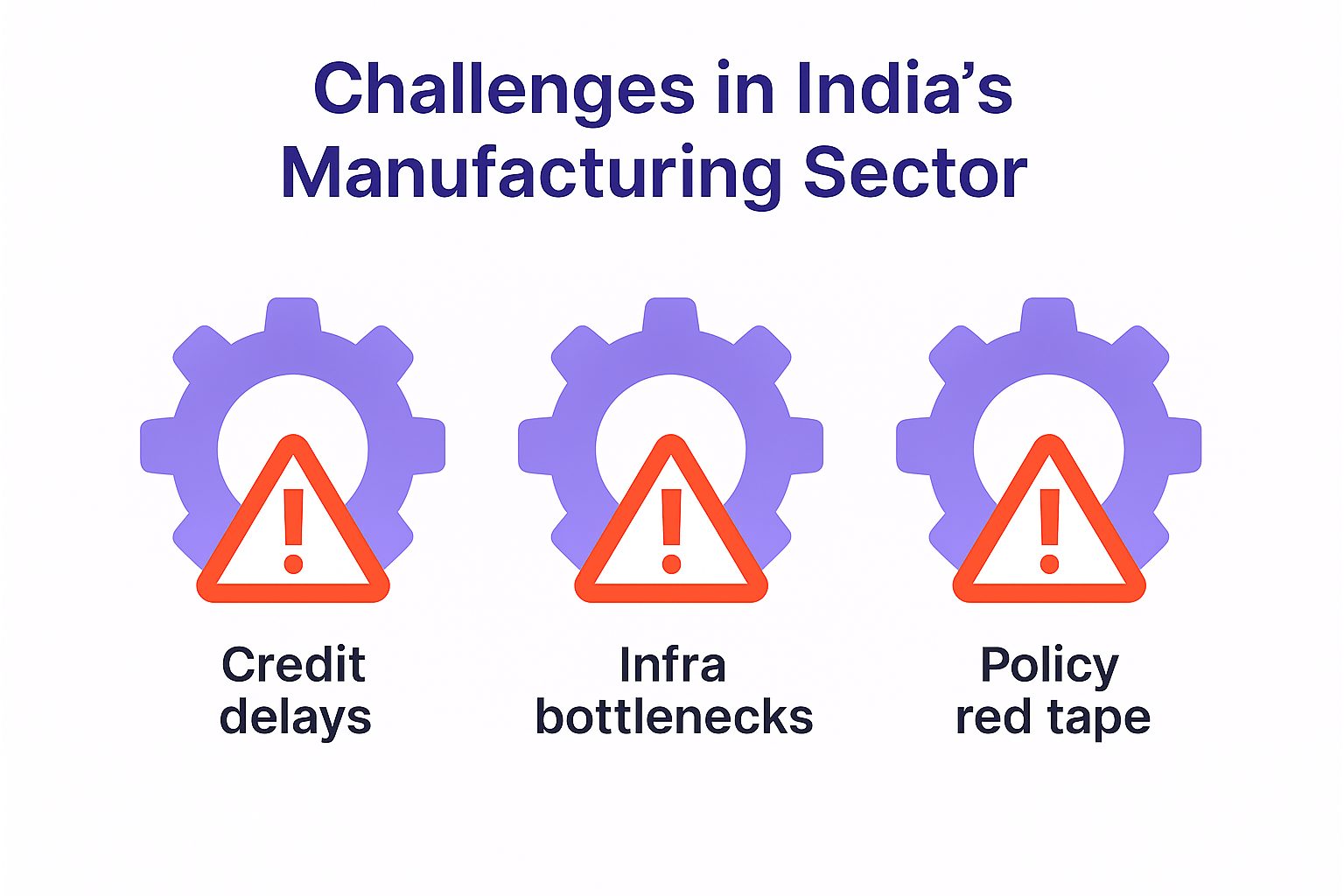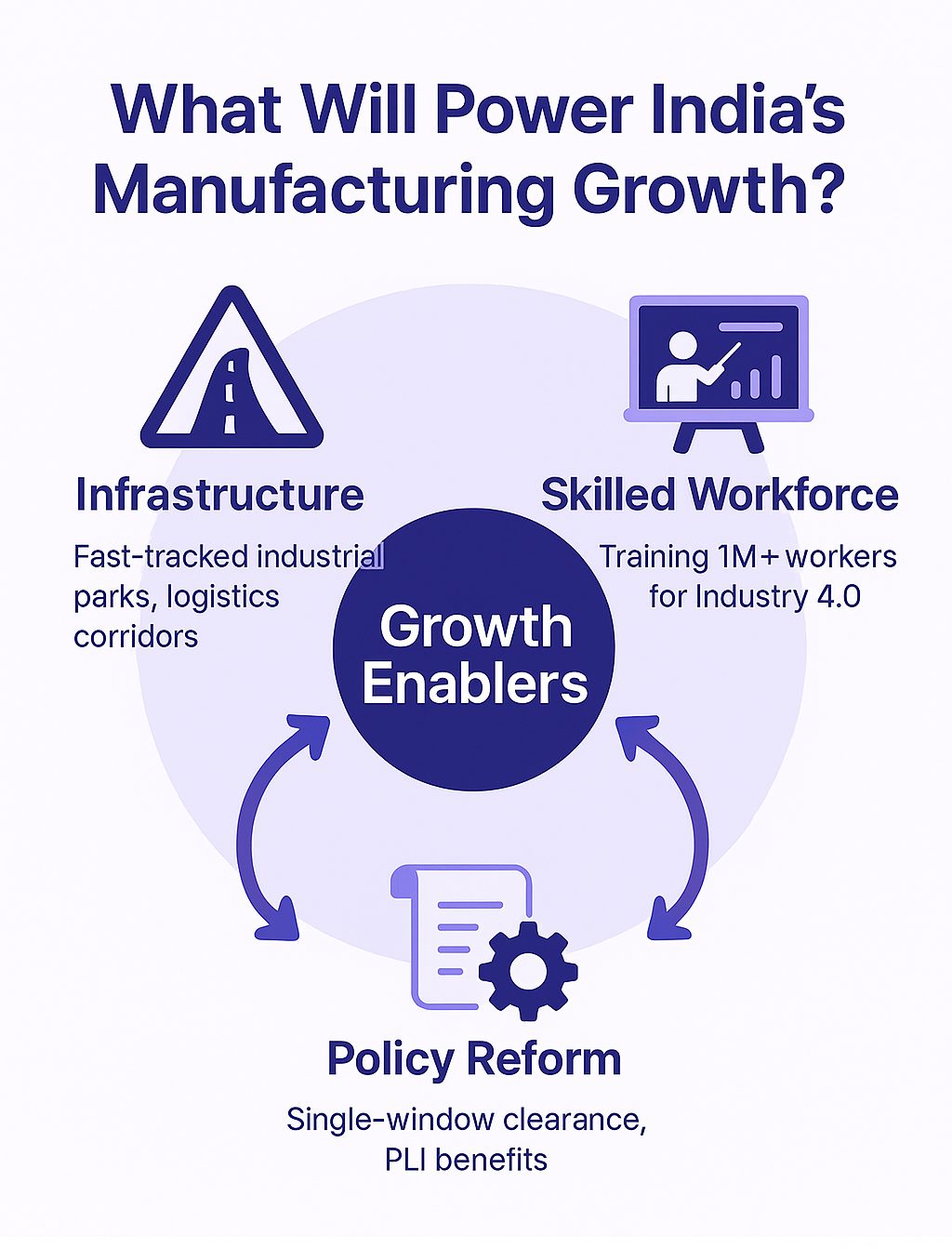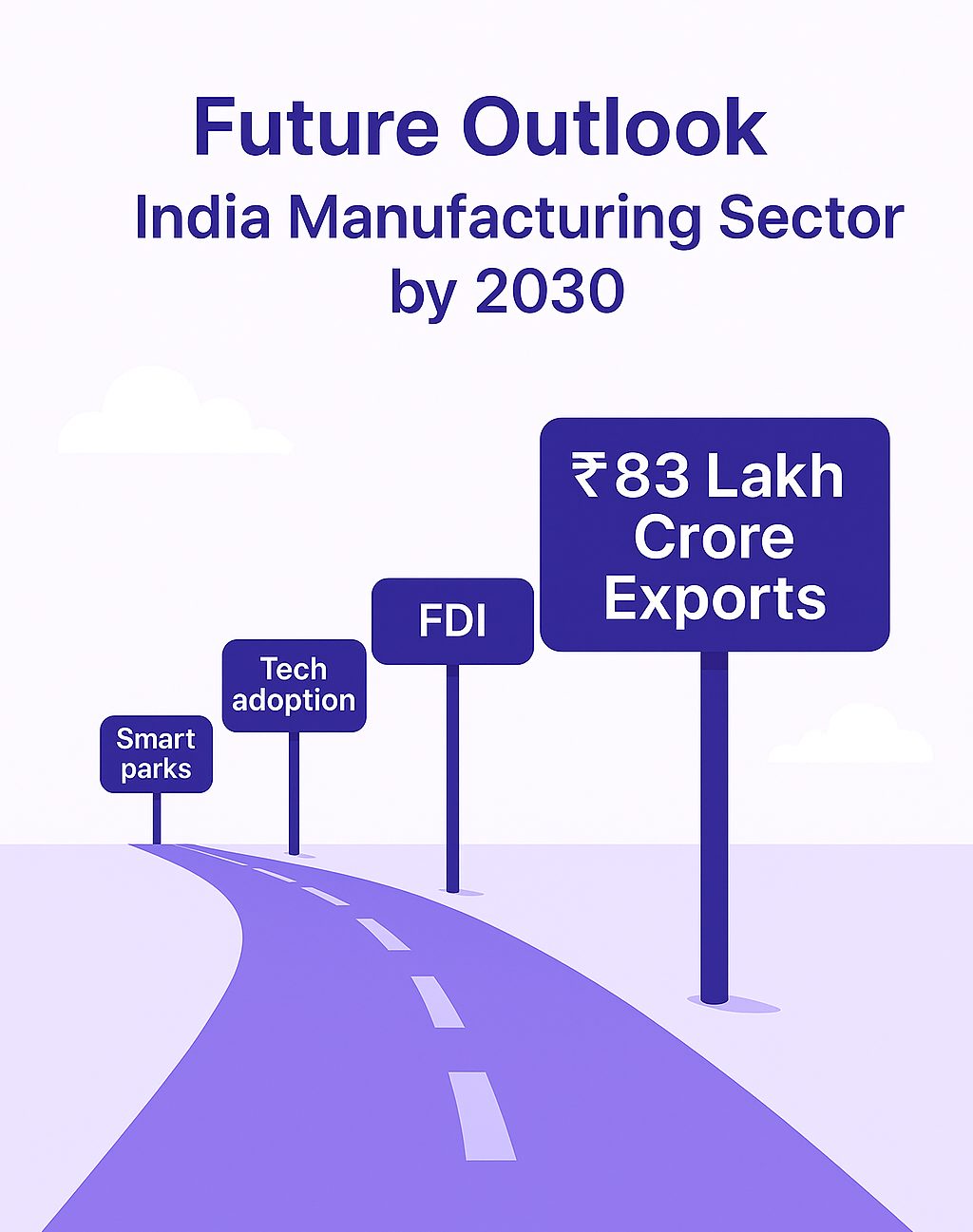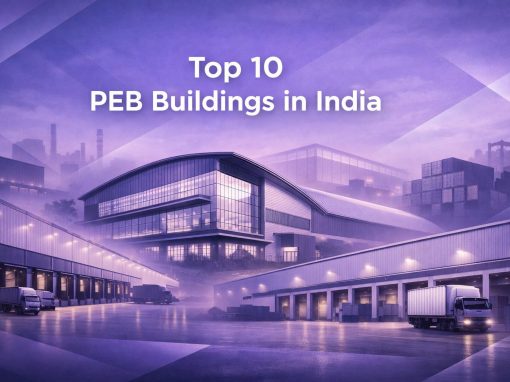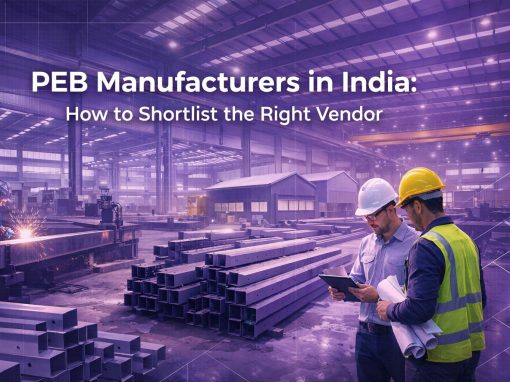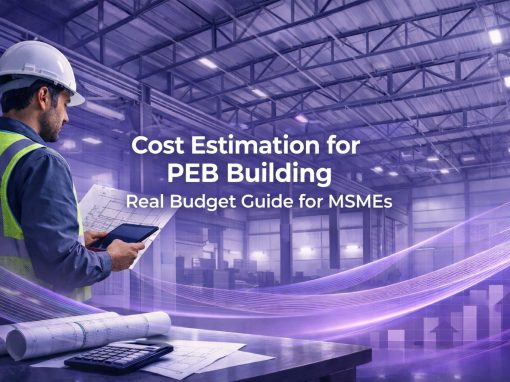Table of Contents
- Introduction
- Manufacturing sector in India
- Market Size Analysis – India Manufacturing Industry
- Top Industrial Manufacturing Clusters
- Manufacturing Sector Companies in India
- Top Manufacturing States in India (2025)
- How to Improve Manufacturing in India
- Key Government Schemes Supporting Manufacturing (2025 Update)
- Conclusion
The manufacturing sector in India—it’s a lot of things at once. Not easy to sum up. You’ve got old techniques, new machines, small setups, massive plants. They all fit in. At the heart of it, it’s about turning stuff—raw stuff—into finished goods. Simple idea, but not simple in practice. It spans everything from crafts to cutting-edge tech.
And now? There’s momentum. Some reports say exports from this sector could hit USD 1 trillion by 2030. That’s a big number. Part of the reason? The middle class. India’s accounts for 17% of global consumption (IBEF). That’s not nothing. So here, in this piece, we’re looking at the space—what’s working, where it’s happening, and why it matters. It’s not just about GDP or jobs. It’s about where India’s headed. And honestly, this sector might just be what gets us there.
Manufacturing sector in India
India’s stepping into the role of a global manufacturing base—not overnight, but piece by piece. Right now, the sector contributes close to 17% of the country’s GDP. And that number could rise, if the pieces fall into place.
Why’s this space such a big deal? Well, it fits both big corporates and small businesses. The government knows this. So, over the past few years, it’s been tweaking policies—bringing in schemes, lowering investment limits, making things easier for newer players.
There’s a plan on paper too. By 2025, the goal is to get manufacturing to make up around 25% of India’s total economic output. Ambitious? Definitely. But with the right push, it’s not out of reach.
India’s got the bones—roads, ports, data networks, manpower. Not perfect, but strong enough to compete. What’s driving this shift? A bunch of things, really:
- Natural resources spread across regions
- Big internal demand and growing export potential
- Tech adoption—things like IoT, AI, smart factories
- Improving logistics, plus port access that actually works
- Tax reforms that trimmed the red tape
- And lately, a serious push toward greener, cleaner manufacturing
The pieces are lining up. Slowly, but steadily.
Market Size Analysis – India Manufacturing Industry
Manufacturing Sector in India isn’t standing still—it’s shifting gears, both in cities and in smaller towns. In FY23, the sector recorded its highest-ever exports: USD 447.46 billion. That’s a 6.03% bump from the year before. Not a small jump.
Zoom in on the numbers for Q1 2024. The manufacturing GVA was estimated at USD 110.48 billion. Compare that to the same quarter in FY22, and you see a clear climb.
What does this mean in plain terms? If the momentum holds, India could be adding over USD 500 billion to the global economy every year—just from manufacturing.
It’s not just about numbers though. The sector also fuels jobs. Back in 2019–20, around 6.24 crore people worked in manufacturing. Industries leading the pack? Think autos, pharma, textiles, and heavy machinery.
Top Industrial Manufacturing Clusters
Some parts of India are just better built for manufacturing. It’s not luck—it’s a mix of roads, ports, people, and years of investment coming together. A 2025 report by Invest India and JLL pointed out what many already knew: a few regions are pulling way ahead.
If you follow the money, it’s mostly going into three things—labour-heavy sectors like textiles and electronics, resource-based areas like food or chemicals, and then the cutting-edge stuff like biotech or chip design.
Let’s go state by state and look at what’s really happening on the ground.
Mumbai, Pune & Aurangabad (Maharashtra)
Maharashtra still holds the crown when it comes to FDI. In 2025, it brought in over USD 16 billion—most of it into manufacturing.
Mumbai’s strength lies in its scale. It’s where most of India’s container cargo moves, thanks to JNPT. But it’s not just about ports. There’s a strong base in textiles, consumer goods, pharma, and even tech hardware.
Pune keeps growing as an auto zone. You’ll find every major global brand with a plant or R&D unit there—German, Japanese, Korean, you name it. Aurangabad used to be overlooked, but not anymore. AURIC, the new smart city nearby, is filling up with auto and electronics companies fast.
Noida, Gurugram & NH48 (Delhi NCR, Haryana, UP)
Drive along NH48 and you’ll see why this stretch matters. It connects Delhi to Mumbai and passes through one of India’s most active industrial corridors.
Gurugram and Manesar are still core to four-wheeler manufacturing. Big OEMs run full-scale operations there. Down the road in Bawal, it’s mostly ancillaries and tier-1 vendors.
Noida is where electronics manufacturing is booming. Phones, components, appliances—it’s all happening. In 2025, Noida led mobile exports for India. The factories here don’t sleep.
What’s changed lately? Infrastructure. Roads are better. Warehousing is sharper. Exports are moving faster. And investors are showing up again.
Hyderabad, Bengaluru & Chennai (Telangana, Karnataka, Tamil Nadu)
This triangle in the south has become one of India’s most balanced zones—tech, pharma, textiles, automobiles, everything.
Bengaluru isn’t just about software anymore. Now it’s known for chip design, aerospace R&D, and even some EV innovation. The ecosystem is shifting.
Hyderabad keeps its pharma crown. Companies here are making everything from generics to vaccine inputs. The local biotech startups are growing too.
Then there’s Chennai. It has more factories than any other city. With 12 ports nearby, it’s built for exports. Automobiles, leather, machinery, you name it—this city ships it.
And the states are stepping up. Tamil Nadu, Telangana, and Karnataka all rolled out sector-specific manufacturing policies in 2025.
Ahmedabad, Vadodara & Mandal (Gujarat)
Gujarat has always been an industrial state, but now it’s gunning for something bigger.
Ahmedabad still leads in chemicals and pharma. Nearly half of India’s chemical exports come from here. That hasn’t changed.
What’s new is the semiconductor buzz. Tata’s massive fab project—estimated at $14 billion—is coming up in Gujarat. If it lands, this will be India’s chipmaking capital.
Mandal–Becharaji is also getting a lot of attention. It’s turning into a serious auto cluster, especially for two-wheelers and small cars.
Vadodara’s niche is power transmission gear. And it’s exporting more of it than ever before.
Quick snapshot
| Region | What’s happening in 2025 |
| Mumbai–Pune–Aurangabad | Auto, smart city growth, pharma, highest FDI |
| Noida–Gurugram–NH48 | Electronics hub, car makers, better logistics |
| Hyderabad–Bengaluru–Chennai | Pharma, chips, EV, ports, textiles—all in one zone |
| Ahmedabad–Vadodara–Mandal | Chemicals, semiconductors, auto, power equipment |
Manufacturing Sector Companies in India
Some companies have shaped India’s manufacturing story from the ground up. These aren’t just big names—they’re the ones running massive plants, supplying everyday essentials, and quietly powering a chunk of India’s economy. Here’s a quick look, sector by sector.
- Steel – Tata Steel
Still one of the most recognisable names in Indian industry. Old roots, but always expanding—domestically and beyond. They’ve stayed ahead on sustainability too. - Aluminium & Copper – Hindalco
Not just metals—they’ve got operations that stretch into value-added products and even packaging. Part of the Aditya Birla Group. - Automobiles – Maruti Suzuki
If you’ve ever been in Indian traffic, chances are you’ve sat in one of their cars. Still the most dominant carmaker in the country by far. - Two-Wheelers – Hero MotoCorp
Known for scale. Bikes that are built for everyday India. Their reach even goes beyond the country now. - Heavy Engineering – L&T
These guys build things most people never see up close—bridges, reactors, defence systems. They’re the quiet backbone of big projects. - Petrochemicals – Reliance Industries
They don’t just refine oil—they’re everywhere in plastics, fibres, even telecom now. But their Jamnagar setup still turns heads. - Paints – Asian Paints
Started with colours, now into coatings, waterproofing, home interiors. Big name, big presence. - Electrical Equipment – BHEL
Government-owned, but still relevant. Makes turbines, power gear, and supplies to power plants across India. - Pharma – Sun Pharma
Generic meds, exports, specialty drugs. If there’s one pharma company that shows up everywhere—from small-town chemists to hospitals abroad—it’s them.
Top Manufacturing States in India (2025)
Some states have figured out the mix—policy, land, power, logistics—and they’re pulling ahead in 2025. Here’s a quick breakdown of the five that are doing the heavy lifting right now:
| State | What’s Working |
| Maharashtra | Still tops the charts. Auto clusters, pharma exports, and highest FDI intake. |
| Tamil Nadu | Most factories in the country. Strong in EVs, textiles, and engineering exports. |
| Gujarat | Leads in chemicals, semiconductors, and container manufacturing. Infra is solid. |
| Karnataka | Home to aerospace, EV startups, chip design. Precision tools sector growing fast. |
| Uttar Pradesh | Noida’s electronics zone is booming. Auto players showing up along new corridors. |
A few notes:
- Maharashtra leads in volume, but Tamil Nadu is gaining on factory count.
- Gujarat’s focus on industrial policy speed is giving it an edge in tech-led sectors.
- UP has stepped up its game—especially in mobile manufacturing and logistics parks.
Not perfect setups. But these five? They’ve got momentum.
How to Improve Manufacturing in India
India’s manufacturing sector has the energy. The ambition. What it lacks, sometimes, is the frictionless path to grow. There’s no single silver bullet—but there are areas where fixing the basics can change everything.
The government’s laid the groundwork. Programs like SAMARTH Udyog Bharat 4.0 are helping manufacturers take steps toward Industry 4.0—encouraging adoption of smart tech and automation. Then there’s the ZED certification scheme, aimed at MSMEs. It rewards better quality, sustainability, cleaner production. All of this matters. But it can’t stop there.
Infrastructure: It still breaks the flow
Many industrial zones are still let down by the simple stuff—roads that flood, power that cuts off, logistics that don’t link up. A manufacturing hub can’t function on promises. It needs ports that move, internet that holds, and systems that actually talk to each other. Otherwise, delays become normal—and normal kills momentum.
Skills: We’ve got the numbers, not the match
India’s workforce is massive. But what factories need and what workers know? That gap stays wide. Most training programs are city-focused. They don’t reach the rural talent. Places like Chennai and Bengaluru have solid MSME training centres—but India needs 50 more, in Tier 2 and Tier 3 towns. And they need to teach not just machines, but process, problem-solving, and production thinking.
Policy: Still clunky in all the wrong places
Doing business has improved—but it’s still uneven. One permit’s fast, another takes months. Inspections that weren’t scheduled show up anyway. To scale manufacturing, rules have to be clear, fast, and consistent—especially for new entrepreneurs.
Fix these three, and the sector won’t just grow. It’ll explode.
Key Government Schemes Supporting Manufacturing (2025 Update)
2025’s full of schemes. Not all are useful—but a few are showing up in real conversations, especially among MSMEs trying to grow. Here’s what folks are actually using (or trying to).
- PLI (Production Linked Incentive)
Covers 14 sectors now. If you make more—mobiles, APIs, air conditioners, whatever—and hit their targets, you get paid. It’s paperwork-heavy, yes. But the money does come. - PM MITRA
Seven mega parks for textiles. Not just land—they’re offering infrastructure, utilities, shared testing labs, even storage. If you’re in garments or fabric, it’s worth checking. - Make in India 2.0
Now sharper. Big push for EVs, defense, electronics. FDI rules are easier, and approvals—at least in some states—aren’t dragging like they used to. - ZED Certification
Helps small units prove quality. Cleaner processes, fewer defects. Some exporters ask for it now. Not mandatory—but good to have. - Udyam Assist
For folks flying under the radar. No GST? No PAN? Still gives a way to get registered and apply for loans or tenders. - Credit Guarantee Scheme (CGTMSE)
No collateral, loans up to ₹5 crore. Still some hoops, but less than before. Banks are finally opening up a bit.
No scheme fixes everything. But used right—they help.
Conclusion
The thing about India’s manufacturing sector? It’s nowhere near its peak.
There’s serious momentum behind the scenes—new factories, FDI inflows, automation pilots, export deals, and supply chain linkages being built in real-time. And investors are noticing. In 2025, foreign investment has picked up across key categories—mobile devices, EVs, chemicals, even container manufacturing. There’s talk of close to USD 2.2 billion in fresh incentives for domestic production in half a dozen sectors.
The long-term ambition? USD 1 trillion in manufacturing exports. It’s bold—but not impossible.
What’s driving this optimism? A mix of things: rising internal demand, a growing middle class, tech adoption by even smaller MSMEs, and government schemes that (finally) seem to be sticking. From luxury goods to life sciences, brands are seeing India not just as a market—but as a maker.
There’s a window here. And if we lean into it—fix bottlenecks, train better, push digital faster—the next phase won’t just be growth. It’ll be scale.
Empowering MSMEs to grow smarter
Tata nexarc delivers powerful solutions for MSMEs—discover tenders, logistics solutions, and streamline procurement. Everything your business needs, all in one place.
FAQs
What licenses are required to start a manufacturing business in India?
How can MSMEs find government tenders related to manufacturing?
What are the environmental compliance requirements for manufacturers in India?
Which sectors are most profitable for small-scale manufacturing in India?
Is contract manufacturing allowed for MSMEs in India?
What is the role of EPCG scheme in manufacturing exports?
Can foreign companies set up manufacturing units under 100% FDI?
Are there any tax benefits for manufacturing startups in India?
What are the challenges of labour law compliance in manufacturing?
How is Industry 4.0 adoption progressing among MSMEs in India?
Sohini is a seasoned content writer with 12 years’ experience in developing marketing and business content across multiple formats. At Tata nexarc, she leverages her skills in crafting curated content on the Indian MSME sector, steel procurement, and logistics. In her personal time, she enjoys reading fiction and being up-to-date on trends in digital marketing and the Indian business ecosystem.
